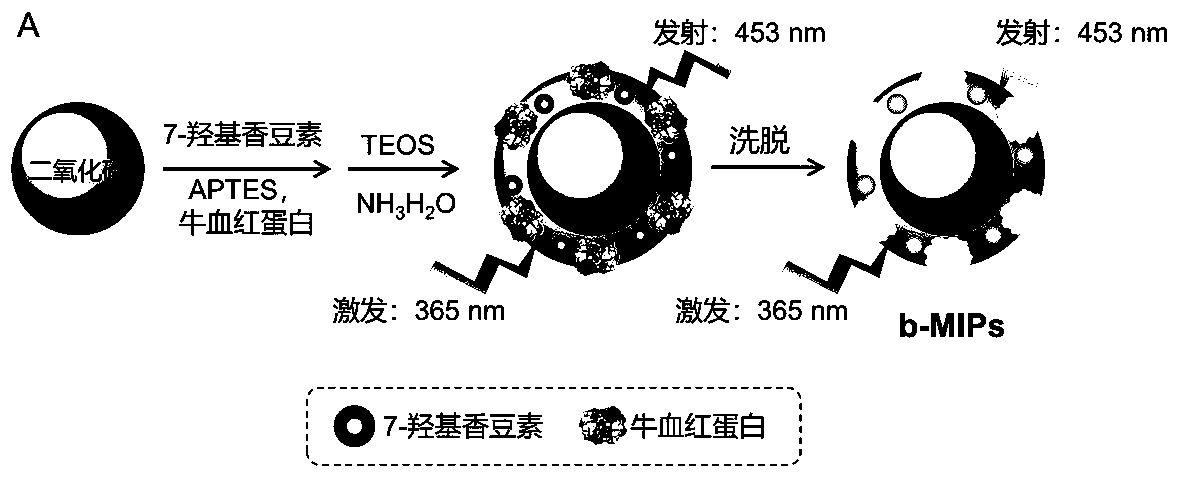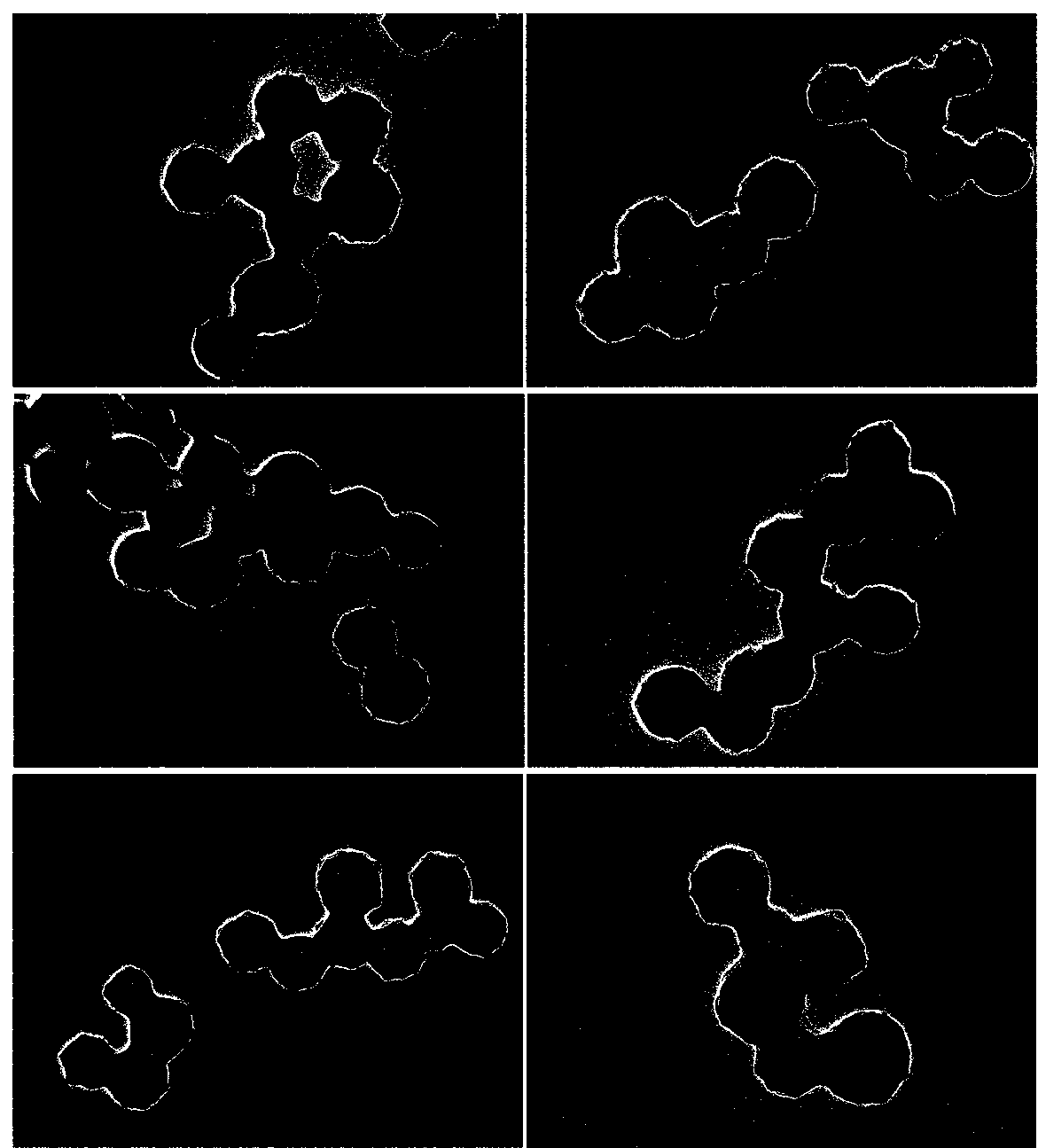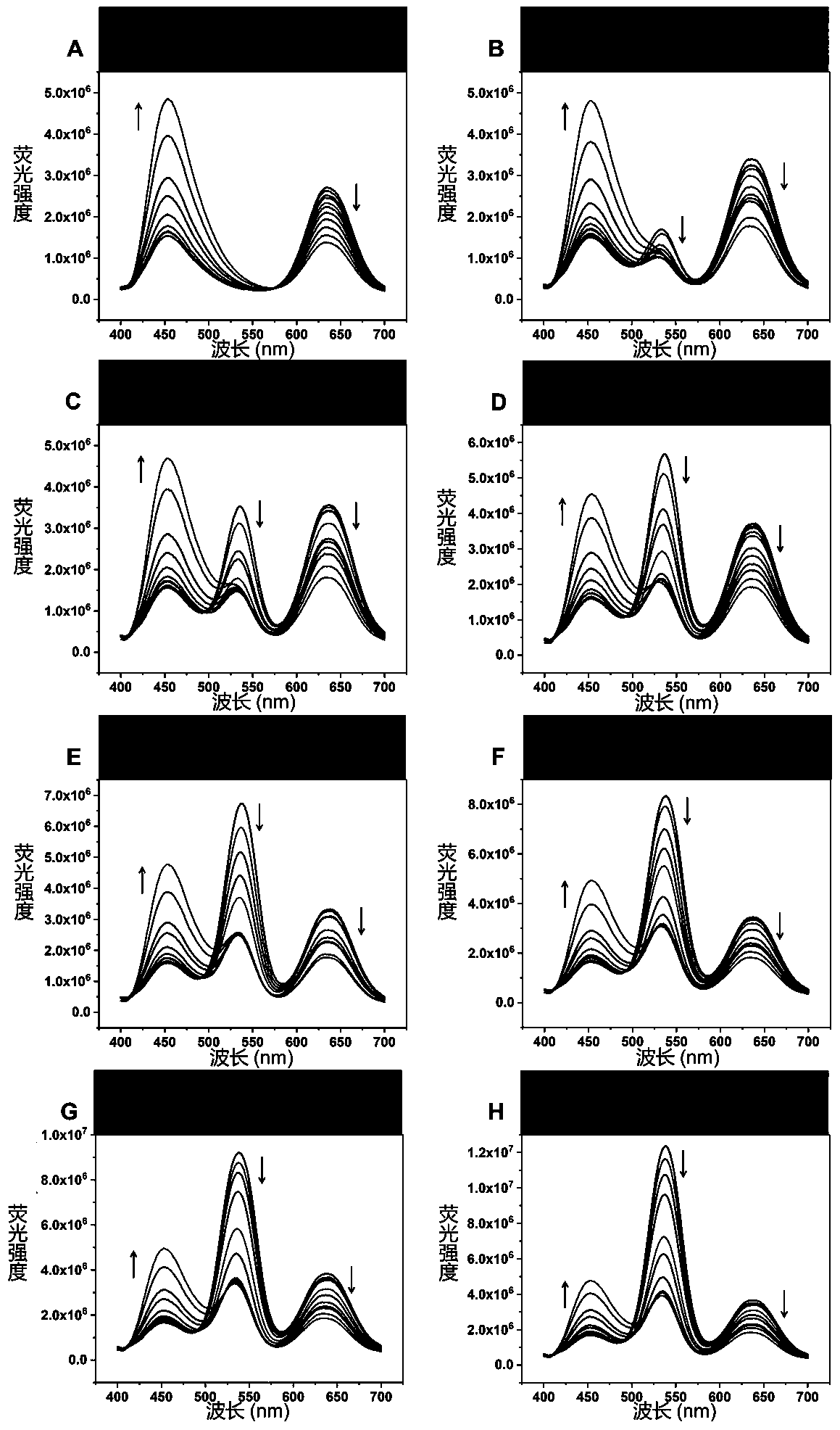Tri-fluorescent emission molecularly imprinted sensor and preparation method and application thereof
A molecular imprinting and fluorescence emission technology, applied in the field of analytical chemistry and rapid detection, can solve the problems of inability to accurately visualize the detection target, complicated optimization process of emission peak intensity ratio, narrow fluorescence color variation range, etc., and achieve rich fluorescence color variation. , The effect of reducing the experimental cost and shortening the experimental period
- Summary
- Abstract
- Description
- Claims
- Application Information
AI Technical Summary
Problems solved by technology
Method used
Image
Examples
Embodiment 1
[0036] Preparation of three fluorescence-emitting molecularly imprinted sensors:
[0037] (1) Prepare bovine hemoglobin imprinted microspheres, take blue fluorescent bovine hemoglobin imprinted microspheres as an example, see figure 1 :
[0038] Add 10 mg of silica microspheres with a particle size of about 79 nm, 10 mg of bovine hemoglobin and 35 μL of 3-aminopropyltriethoxysilane (APTES) into 20 mL of phosphate buffer (0.01 M, pH 7.0), and stir for 1 After 1 hour, add 20 mg of blue fluorescent 7-hydroxycoumarin, mix well and continue to add 56 μL tetraethyl orthosilicate (TEOS) and 56 μL ammonia water (NH 3 ·H 2 O), the sol-gel polymerization was carried out in the dark for 10-12 hours. After the reaction is completed, the product is precipitated by centrifugation (8000rpm, 5 minutes), the supernatant is discarded, and the bovine hemoglobin in the precipitate is eluted with 0.5% Triton X-100 to obtain a blue fluorescent bovine hemoglobin blot with a nucleocapsid structure...
Embodiment 2
[0045] The above obtained red fluorescent bovine hemoglobin imprinted microspheres (r-MIPs) dispersion, blue fluorescent bovine hemoglobin imprinted microspheres (b-MIPs) dispersion and green fluorescent bovine hemoglobin imprinted microspheres (g-MIPs) dispersion were The sensor was obtained by mixing in phosphate buffer (0.01 M, pH 7.0) in proportion; the total volume of phosphate buffer (0.01 M, pH 7.0) was controlled at 1 mL, and the amount of red bovine hemoglobin imprinted microspheres (r-MIPs) was fixed 5% (volume fraction), the amount of blue bovine hemoglobin imprinted microspheres (b-MIPs) was fixed at 6% (volume fraction), and the amount of green bovine hemoglobin imprinted microspheres (g-MIPs) was 0%, 3%, respectively. 5%, 7%, 9%, 11%, 13% and 15%; then add different amounts of bovine hemoglobin to the above sensor to make the final concentration 0, 0.025, 0.05, 0.075, 0.1, 0.25, 0.5, 0.75 , 1, 2 and 3 μM; add bovine hemoglobin and mix well, react for 8 minutes, a...
Embodiment 3
[0048] Different sensors are prepared according to the sensor preparation method described above. Specifically, the different microspheres obtained above are mixed in a buffer in a certain proportion to obtain different sensors with different selections and different proportions; among them, red-green-blue three fluorescent emission molecular imprints r-MIPs in the sensor: g-MIPs: b-MIPs=5%:11%:6% (volume percentage), red-green-blue three fluorescent emission non-imprinted sensor r-NIPs: g-NIPs: b-NIPs =5%:11%:6% (volume percentage), r-MIPs: g-MIPs in the red-green dual fluorescent emission molecularly imprinted sensor =5%:11% (volume percentage), red-blue dual fluorescent emission molecularly imprinted sensor r-MIPs in the sensor: b-MIPs=5%:6% (volume percentage), g-MIPs in the green-blue dual fluorescence emission molecularly imprinted sensor: b-MIPs=11%:6% (volume percentage); and, The total volume of phosphate buffer (0.01 M, pH 7.0) in each of the above sensors was contro...
PUM
| Property | Measurement | Unit |
|---|---|---|
| The average particle size | aaaaa | aaaaa |
Abstract
Description
Claims
Application Information
 Login to View More
Login to View More - R&D
- Intellectual Property
- Life Sciences
- Materials
- Tech Scout
- Unparalleled Data Quality
- Higher Quality Content
- 60% Fewer Hallucinations
Browse by: Latest US Patents, China's latest patents, Technical Efficacy Thesaurus, Application Domain, Technology Topic, Popular Technical Reports.
© 2025 PatSnap. All rights reserved.Legal|Privacy policy|Modern Slavery Act Transparency Statement|Sitemap|About US| Contact US: help@patsnap.com



